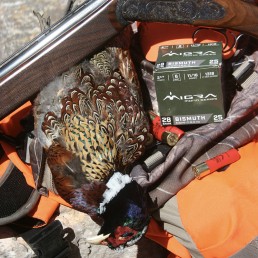Clay Target Loads Taking to the Lighter Side of Recoil
SHARE THIS POST
We are recently seeing a wider range of soft-shooting clay target loads being offered to shooters. I attribute this newer direction toward shotshell loads designed for more shooters advancing in years, thereby not liking much heavy recoil on the clays course. Or for hunters taking on small game and now buying more lightweight, smaller-gauge shotguns than in years past.
As such, loads like Remington’s brand new “Low Decibel” 410 Bore loads are starting their trip to sporting goods store shelves, as are sister loads in 12-gauge “Low Recoil” with some reduction in velocity as well.
Remington’s Low Decibel 410s retain 1/2-ounce of #9 lead and are loaded to 650 f.p.s. at the muzzle. While this is a nice little package for 410 wheel guns, or shooting super-close range clays, it is not advised in terms of being workable for game animals beyond in-your-face range limits.
I have been working through 410 bore loads for the past five years and have gained a great deal of data and on-site real-time, warm-target reviews covering wound channels. After finishing a major, hand-loading manual story covering 410 bore TSS super loads in 3-inch hulls for Hodgdon Powders, I tend to believe that my current information regarding the 410 bore is as about as up to date as you’ll get. My findings indicate that keeping the 410 at 950 f.p.s., or just under the speed of sound, can do wonders for patterns, muzzle blast reduction, and the ability to reuse spent hulls over a reloading press.
Shooting two 410 side-by-sides during the Shot Show 2024 last year, I found that the Remington flavor in massively reduced sub loads, applied to the brand new Citadel Legacy Sports “Boss SS Coach Gun,” would be workable for barn rat reduction practices; and again for pigeon control in dairy operations when contamination of animal feed can be a serious problem.
Beyond that, the move up in velocity to 950 is not only advised regarding 410 loads, but mandatory against targets like wild turkeys, of which I have harvested four trophy-class birds with that handloaded system. Will the industry follow my lead? If they read Hodgdon’s 2025 manual on the 410 handloading of TSS and even lead shot, it is a no-brainer of sorts.
During this review, the second 410 bore to take on 410 fodder was the new TriStar Bristol, which is a long, 28-inch-barreled beauty with its engraved bright steel receiver and straight-grained walnut stock. The gun pulled up like it was custom built for me and retained a weight of only 5 1/2 pounds dry. After shooting both handloaded TSS #9’s, which were built at home using Ballistics Products manuals and components across the board, I became sold on both the gun and loads. Regarding 410 performance today, the new components and exceptionally hard-hitting, tungsten-blended (Hevi Shot), or pure .18 tungsten pellets in small but deadly #9 through #7, are total game changers regarding the little big gun in 410 bore.
Are you enjoying this post?
You can be among the first to get the latest info on where to go, what to use and how to use it!
Shooting Remington Winchester 2-1/2-inch, #6 lead, as well as a reloading-press-built, 1-ounce, 2-1/2-inch subsonic 650 f.p.s. load to match the new Remington 410 offering against crow targets during the South Dakota opening in September this past year, the Citadel carbine-length, twin-pipe shooter chambered in 410 clocked the black bandits stone dead time as they crossed my static blind during a full month of varmint hunting. I am not saying the 2-1/2-inch, subsonic, Remington-style loads should be counted on for pass shooting trash birds over feed lots or on ranch settings, but in heavy timber as crow targets close to under 20 yards over treetops, have at it.
Another advantage to light-payload, quiet loads are outstanding training loads for new-to-the-sport shooters, as well as children getting into the game. Shooting the Citadel side-by-side produced almost no recoil at all, and the muzzle blast was more than tolerable.
In terms of flexibility during my testing series, I packed a wide array of shotguns afield, like the Legacy Sports Citadel in a military-style rifle scabbard pack, while slinging the rifle and day pack into my blind-style hide. During the first days of shooting along that waterway, the sniper-style hide offered up several problem raccoons, a single skunk, and enough crows, starlings and pigeon targets for the 410 bore to make the effort hauling the lightweight, short-barreled, extra shotgun into the blind worthwhile.
With two 410 bores in use over several months, and both guns sent by the manufacturer for testing with sets of five total choke tubes, I was ready for just about any warm targets applied to the 410 bore shotgun.
When extended range shooting was an issue, I wanted a more extended sight plane in the 410 double-barrel shotgun to match the problem. The TriStar got the call. This 28-inch-barreled mini-gun added just enough sight plane advance to allow me to also test custom-loaded 1-ounce tungsten loads being considered for market by Backridge in 2025.
For more insight and tips on how to make the most of the time you spend hunting, check out the articles in every issue of MidWest Outdoors, available by subscribing on our website.
MWO
SHARE THIS POST
You may also like...
Nothing found.
Did you enjoy this post?
You can be among the first to get the latest info on where to go, what to use and how to use it!
L.P. Brezny
Writing on outdoor subjects for over 40 years, L.P. Brezny has written four books on shotgun and rifle (ballistics and performance). He’s an expert at smoothbore, and high-power, ultra-long-range shooting. He’s a specialist, producing reviews covering general products used in the outdoors industry.
